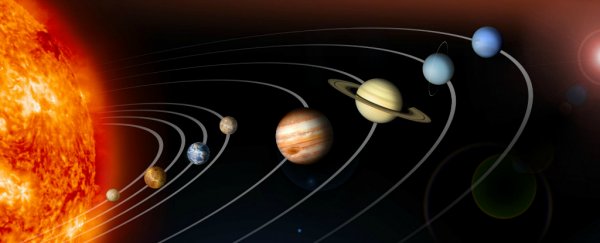Researchers from Canada have used computer models to show that our Solar System could have had an extra gas giant planet in the mix around 4 billion years ago – until Jupiter booted it out, that is.
The idea that there were originally five gas giants – in addition to Jupiter, Saturn, Uranus, and Neptune – was first proposed back in 2011, to help explain why the Solar System currently looks the way it does. As it turns out, the orbit of Mars and Earth don't really make sense if there were only ever the planets we have today.
But researchers haven't been able to explain until now what could have happened to that extra planet, with both Jupiter and Saturn named as potential culprits for doing the kicking out.
"Our evidence points to Jupiter," said lead researcher Ryan Cloutier from the University of Toronto, who describes the whole thing as an "interplanetary chess game".
The mystery lost planet in question is believed to have had the mass of an ice giant, which means that it was heavier than Saturn and Jupiter, and in the same class as Neptune and Uranus. So how exactly does a lighter planet suddenly kick an ice giant clear out of the Solar System?
Planetary ejections generally happen as a result of a close planetary encounter - but not necessary a collision - which causes one of the objects to accelerate so rapidly that it's able to break free from the massive gravitational pull of the Sun and go slingshotting out into the galaxy, becoming what's known as a rogue planet.
In this case, the ejection could be the result of Jupiter moving closer to the Sun from further out in the Solar System, affecting the orbit of other planets on its way.
Earlier studies had struggled to work out exactly which of the remaining planets could have done this, but in the new research, the astronomers from the University of Toronto realised that up until now, no one had factored in the effect this encounter would have had on the moons orbiting the giant planets.
So the team decided to look at the trajectories of Callisto and Iapetus – two of the regular moons orbiting Jupiter and Saturn respectively. Using computer models, they investigated the likelihood of the moons having the same orbit as they do today if they'd been involved in a mass planetary ejection 4 billion years ago.
"Ultimately, we found that Jupiter is capable of ejecting the fifth giant planet while retaining a moon with the orbit of Callisto," said Cloutier. "On the other hand, it would have been very difficult for Saturn to do so because Iapetus would have been excessively unsettled, resulting in an orbit that is difficult to reconcile with its current trajectory."
The computer model showed that there's about a 42 percent chance that Callisto would have its current orbit around Jupiter if it had been involved in the planetary ejection. The results have been published in The Astrophysical Journal.
But to be clear, this doesn't mean that we have any evidence this interaction actually took place, or even that there was an extra planet in the Solar System in the first place. This is all based off computer models, and while they can explain the current state of the planets in our Solar System, they're not the only possibilities out there.
"We do know that rogue planets roam the galaxy, and they were almost certainly ejected in this manner, so the idea of a lost solar system planet isn't crazy," wrote astronomer Phil Plait for Discover back in 2011 when the missing planet hypothesis was first proposed. "But it's only one possible scenario."
Still, it's kind of cool to think that, somewhere out there in the galaxy, a frozen ice giant is roaming, a lost remnant from the formation of our Solar System.
